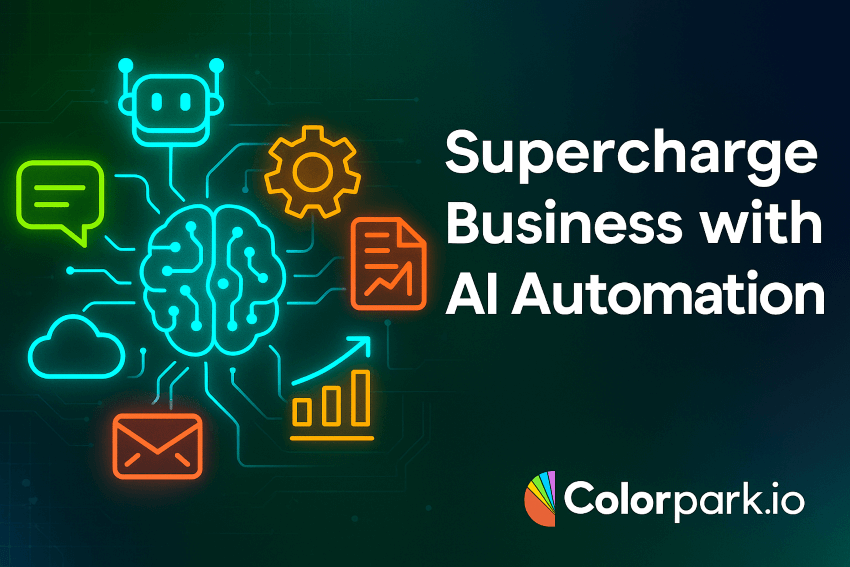Introduction
Imagine if your business could run smoother, faster, and smarter—while you focus on strategy, creativity, and growth. That’s exactly what AI-powered automation makes possible.
Most business owners and managers are stuck in a loop of repetitive tasks: sending follow-up emails, managing spreadsheets, updating reports, or handling customer queries. These tasks eat up valuable time and energy that could be better spent scaling the business.
Here’s the good news: Artificial Intelligence (AI) has evolved into one of the most powerful tools to streamline workflows, cut costs, and boost productivity. From automating customer support to predicting sales trends, AI can unlock growth opportunities you didn’t even realize you had.
In this ultimate guide, you’ll learn:
- What AI business automation really means (and why it matters)
- Real-world examples of AI boosting productivity
- The best AI tools for business automation in 2025
- How to implement AI step-by-step without overwhelming your team
- Common mistakes to avoid when automating with AI
By the end, you’ll have a clear roadmap to supercharge your business with AI-powered automation—and stay ahead of competitors who are still stuck in manual mode.
H2: What is AI Business Automation?
Business automation isn’t new. Companies have been using software for decades to handle payroll, scheduling, and emails. But AI takes this a step further by not just doing tasks, but also thinking, adapting, and learning from data.
- Traditional automation = rule-based (e.g., “If X happens, do Y”).
- AI automation = intelligent, predictive, and adaptive.
For example, instead of simply sending a reminder email at 5 PM, an AI-powered system analyzes your customer’s behavior and sends the message at the exact time they’re most likely to open and engage.
👉 In short, AI doesn’t just save time—it makes smarter decisions that increase impact.
H2: Why Businesses Can’t Ignore AI in 2025
AI is no longer a futuristic concept. It’s embedded into tools you already use—like Gmail’s smart reply, LinkedIn’s content suggestions, or Shopify’s product recommendations.
Here’s why it matters for your business right now:
- Time Savings: Automating repetitive tasks frees your team to focus on higher-value work.
- Cost Reduction: AI can cut operational expenses by reducing errors and optimizing workflows.
- 24/7 Operations: AI tools don’t sleep—they serve customers, analyze data, and optimize performance around the clock.
- Competitive Edge: Early adopters of AI enjoy better efficiency, faster decision-making, and higher ROI.
H2: Practical Examples of AI in Business Automation
Let’s break down how companies are already using AI to get ahead:
H3: AI in Marketing
- Personalized email campaigns based on customer behavior.
- AI-driven ad optimization that improves ROI without manual tweaks.
- Social media content generation that stays on brand and saves hours.
H3: AI in Sales
- Predictive lead scoring to identify which prospects are most likely to convert.
- Automated CRM updates and reminders to follow up.
- AI chatbots qualifying leads before handing them to sales teams.
H3: AI in Customer Service
- 24/7 chatbots that resolve 80% of basic customer queries.
- Sentiment analysis to detect unhappy customers early.
- Smart knowledge bases that learn and improve over time.
H3: AI in Operations
- Supply chain optimization with predictive analytics.
- AI-driven scheduling that balances workloads.
- Fraud detection systems protecting financial transactions.
H2: Best AI Tools for Business Automation in 2025
Here are some of the most effective categories and examples:
- AI for Communication: ChatGPT, Jasper, Grammarly Business
- AI for Sales & CRM: Salesforce Einstein, HubSpot AI, Zoho Zia
- AI for Marketing: SurferSEO, Copy.ai, AdCreative.ai
- AI for Analytics: Tableau AI, Google Analytics Intelligence
- AI for Operations: UiPath, Zapier with AI integration, Monday.com AI
👉 The best tool isn’t always the most expensive—it’s the one that fits your workflow.
H2: Step-by-Step Guide to Implementing AI Automation
-
Audit Your Current Workflow
- Identify repetitive, time-consuming tasks.
- Note where human error costs you money.
-
Set Clear Goals
- Is your priority saving time, cutting costs, or increasing conversions?
-
Choose the Right AI Tools
- Start with one or two areas (e.g., marketing or customer support).
-
Pilot Small Projects
- Test on a limited scale before rolling out across departments.
-
Train Your Team
- Ensure employees understand how AI complements (not replaces) their work.
-
Measure and Optimize
- Use KPIs like saved hours, cost reductions, or improved customer satisfaction.
H2: Common Misconceptions About AI
-
“AI will replace humans.” False. AI automates repetitive tasks, while humans handle strategy and creativity.
-
“AI is too expensive for small businesses.” Wrong. Many AI tools now offer affordable subscriptions for startups.
-
“AI is complicated to set up.” Not anymore—many tools integrate with apps you already use.
H2: How AI Increases Productivity Without Burnout
One of the biggest business challenges today is employee burnout. AI helps by:
- Reducing repetitive admin work.
- Giving employees real-time insights to make better decisions.
- Allowing teams to focus on creative and strategic growth.
H2: Future of AI in Business Automation
Looking ahead:
- Hyper-personalization: Every customer journey tailored by AI.
- Voice-first AI tools: Natural language interfaces replacing dashboards.
- AI-powered decision-making: Recommending actions, not just reporting data.
Businesses that embrace AI now will not just survive but thrive in the next decade.
Bullet Points / Quick Takeaways
- AI business automation saves time, reduces costs, and improves decision-making.
- Start small—automate one area (like marketing or customer support) before scaling.
- Affordable AI tools are available for startups and enterprises alike.
- AI enhances human work—it doesn’t replace it.
- Companies that adopt AI now will lead in productivity and growth tomorrow.
Call to Action (CTA)
🚀 Ready to future-proof your business? Don’t wait until your competitors pull ahead. Start exploring AI automation today. Whether it’s customer support, marketing, or operations, there’s an AI solution designed to help you grow smarter, faster, and stronger.
👉Take the first step: Audit your workflow, pick one AI tool, and start supercharging your productivity today. 👉hire expart
Optional: FAQ Section
Q1: Can small businesses really benefit from AI? Yes! Many AI tools are affordable and scalable for startups. They often save more money than they cost.
Q2: Will AI replace my employees? No. AI handles repetitive work, while humans focus on creativity, strategy, and relationship-building.
Q3: What’s the easiest area to start automating with AI? Customer service (chatbots) and marketing (content, email, ads) are the quickest wins.
Q4: How do I know if AI is working? Track metrics like time saved, reduced costs, increased leads, or customer satisfaction.
Q5: Is AI secure for business use? Yes—reputable AI platforms use enterprise-grade security. Always check compliance with data regulations like GDPR.


